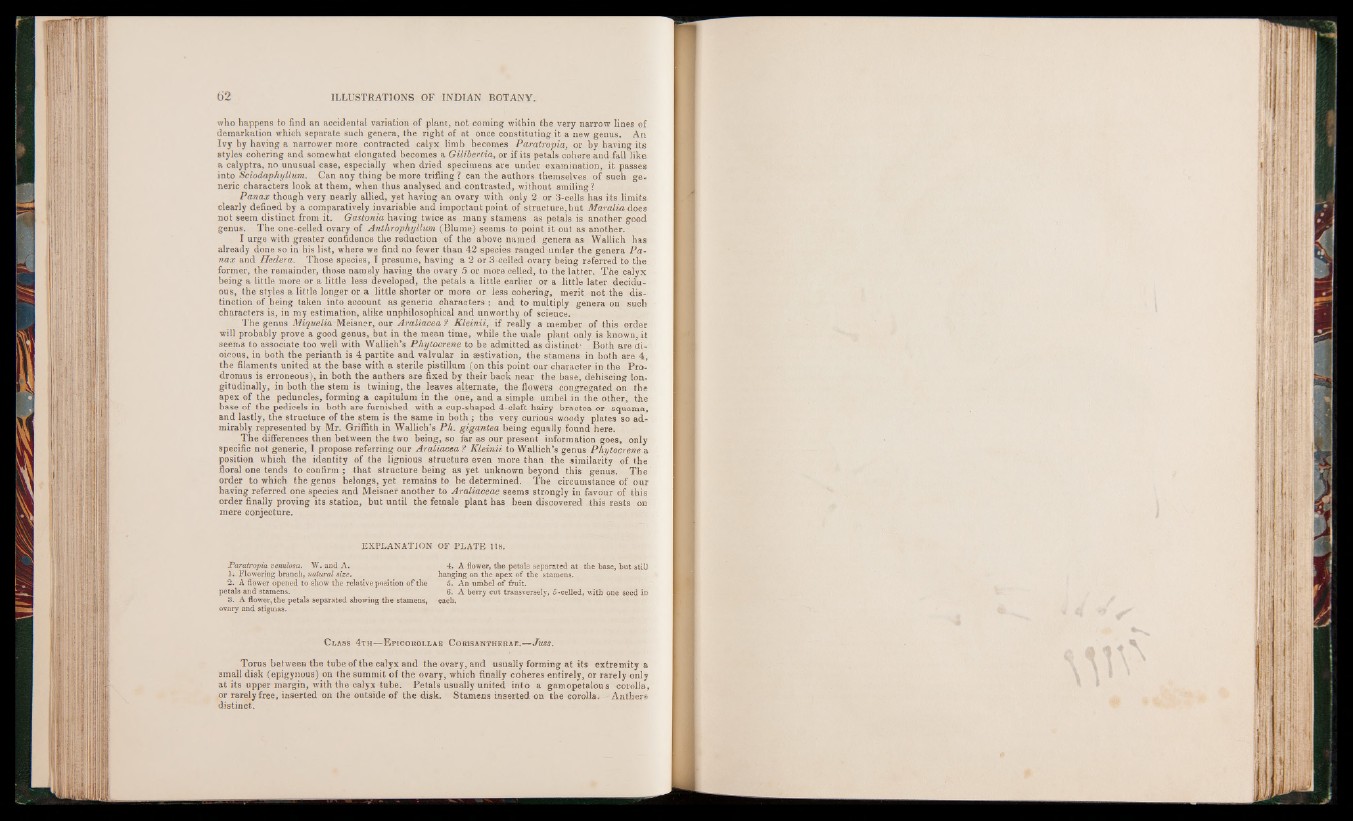
who happens to find an accidental variation of plant, not coming within the very narrow lines of
demarkation which separate such genera, the right of at once constituting it a new genus. An
Ivy by having a narrower more contracted calyx limb becomes Paratropia, or by having its
styles cohering and somewhat elongated becomes a Gilibertia, or if its petals cohere and fall like
a calyptra, no unusual case, especially when dried specimens are under examination, it passes
into Sciodaphyllum. Can any thing be more trifling ? can the authors themselves of such generic
characters look at them, when thus analysed and contrasted, without smiling ?
Panax though very nearly allied, yet having an ovary with only 2 or 3-cells has its limits
clearly defined by a comparatively invariable and important point of structure,but Maralia does
not seem distinct from it. Gastonia having twice as many stamens as petals is another good
genus. The one-celled ovary of Anthrophyllum (Blume) seems to point it out as another.
I urge with greater confidence the reduction of the above named genera as Wallich has
already done so in his list, where we find no fewer than 42 species ranged under the genera Panax
and Hedera. Those species, I presume, having a 2 or 3-celled ovary being referred to the
former, the remainder, those namely having the ovary 5 or more celled, to the latter. The calyx
being a little more or a little less developed, the petals a little earlier or a little later deciduous,
the styles a little longer or a little shorter or more or less cohering, merit not the distinction
of being taken into account as generic characters : and to multiply genera on such
characters is, in my estimation, alike unphilosophical and unworthy of science.
The genus Miquelia Meisner, our Araliacea % Kleinii,’ if really a member of this order
will probably prove a good genus, but in the mean time, while the male plant only is known, it
seems to associate too well with Wallich’s Phytoci'ene to be admitted as distinct- Both are di-
oieous, in both the perianth is 4 partite and valvular in aestivation, the stamens in both are 4,
the filaments united at the base with a sterile pistillum (on this point our character in the Pro-
dromus is erroneous), in both the anthers are fixed by their back near the base, dehiscing longitudinally,
in both the stem is twining, the leaves alternate, the flowers congregated on the
apex of the peduncles, forming a capitulum in the one, and a simple umbel in the other, the
base of the pedicels in both are furnished with a cup-shaped 4-cleft hairy bractea or squama,
and lastly, the structure of the stem is the same in both ; the very curious woody plates so admirably
represented by Mr. Griffith in Wallich’s Ph. gigantea being equally found here.
The differences then between the two being, so far as our present information goes, only
specific not generic, I propose referring our Araliacea ? Kleinii to Wallich’s genus Phytocrene a
position which the identity of the lignious structure even more than the similarity of the
floral one tends to confirm ; that structure being as yet unknown beyond this genus. The
order to which the genus belongs, yet remains to be determined. The circumstance of our
having referred one species and Meisner another to Araliaceae seems strongly in favour of this
order finally proving its station, but until the female plant has been discovered this rests on
mere conjecture.
EXPLANATION OF PLATE 11«.
Paratropia venulosa. W. and A.
1. Flowering branch, natural size.
2. A flower opened to show the relative position o f the
petals and stamens.
3. A flower, the petals separated showing the stamens,
ovary and stigmas.
4. A flower, the petals separated at the base, but still
hanging on the apex of the stamens.
а. An umbel o f fruit.
б. A berry cut transversely, 5 -celled, with one seed in
each.
C lass 4 th—E picorollae Corisantherae.—Juss.
Torus between the tube of the calyx and the ovary, and usually forming at its extremity a
small disk (epigynous) on the summit of the ovary, which finally coheres entirely, or rarely only
at its upper margin, with the calyx tube. Petals usually united into a gamopetalous corolla,
or rarely free, inserted on the outside of the disk. Stamens inserted on the corolla. Anthers
distinct.